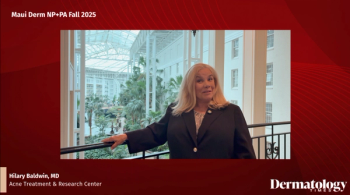
- Dermatology Times, January 2020 (Vol. 41, No. 1)
- Volume 41
- Issue 1
Ultrasound technology may be useful treatment for rosacea
Drs. López and Kaufman discuss two new studies that examine the use of ultrasound technology as a new modality for treatment of erythematotelangiectatic and refractory rosacea.
Rosacea is a chronic inflammatory cutaneous disorder that is subdivided as: erythematotelangiectatic, papulopustular, phymatous and ocular. The pathophysiology is not completely understood, but, in its early stages, it seems to be a manifestation of innate immune system and neurovascular dysregulation.1 Usually treatment involves a combination of avoidance of triggers (e.g. ultraviolet light, heat, spicy foods), topical medication (e.g. metronidazole, ivermectin, permethrin, oxymetazoline), oral medication including antibiotics, isotretinoin and ivermectin and laser therapy.2
Laser treatment of rosacea is predominantly focused on reducing the vascular component that leads to erythema or treating the more chronic phymatous component. There is published evidence for the use of the intense pulsed light, pulsed dye laser, 532 nm KTP, 755 nm alexandrite, long-pulsed Nd-YAG and CO2 devices. More recently, there have been two studies using ultrasound technology with frequencies of 3 to 10 MHz as a new modality for treatment of specifically erythematotelangiectatic and refractory rosacea. Ultrasound technology allows for localized delivery of heat within the dermis without harm to the surrounding tissue. It is thought that this sound wave technology is capable of suppressing matrix metalloproteinases which then leads to downstream anti-inflammatory effects.
Dual frequency ultrasound, capable of operating over dual or multiple frequencies, was studied in a retrospective fashion for treatment of refractory rosacea by Park et al in 2018.3 They reviewed 42 charts of patients with rosacea treated for 12 weeks with 3/4.5 MHz and a constant 4.5 MHz ultrasound wave (Hyperlux, MI Tech Co) twice per week for the first week, followed by one week intervals. They describe a whole face treatment lasting 10 minutes with approximately 10 second per shot. The measured outcomes were erythema index, transepithelial water loss and patient self-assessment. The mean erythema index values decreased from a baseline of 16.3 to 12.7 at week 12 (<.05), transepithelial water loss decreased from a baseline of 35.8 to 22.8 at week 12 (p<.05) and patients also self-assessed improvement of rosacea from baseline to week 12 (p<.01). The treatments were well tolerated, but there was no long-term follow-up.
A second study published by Schlessinger et al earlier this year studied microfocused ultrasound (Ultherapy System) for treatment of erythematotelangiectatic rosacea.4 They enrolled 91 subjects with the diagnosis and randomized them to receive one or two low density treatments or one or two high density treatments. Per their protocol, low density treatment consisted of a minimum of 15 treatment lines per square vs high density which consisted of a minimum of 30 treatment lines per square. They explain each treatment line required approximately three seconds to perform, and no more than two sessions were performed as they were limited by patient discomfort. Treatments were performed 14+/- 4 days apart. Outcomes were measured through analysis of clinician erythema assessment, patient self-assessment, dermatology life quality index, digital images and colorimeter assessment of the red-green spectrum. Across groups, 75-91.3% of patients achieved treatment success at 90 days, de ned as a one-point change in clinician erythema assessment. Moreover, in this study it was noted that a single high-density treatment was the most effective. Notable adverse events were bruising, tenderness and redness. Sustained results were noted at one year follow-up.
Erythema seems to be the most diffiult rosacea symptom to treat. There are many innovative studies examining new topical therapies and new procedural protocols trying to elucidate a reliable and durable way to safely control redness without rebound. Both of these studies remarkably showed objective and subjective improvement of erythema. Interestingly, these two specifc papers used ultrasound technology which did not actually target the telangiectasias themselves, which is what the majority of previous studies focus on, but downregulates the inflammatory cascade that underlies rosacea. Larger randomized trials are necessary to further clarify the treatment protocols and settings required to achieve positive patient outcomes and to further elucidate the precise mechanism of action.
Disclosures:
Dr. Lopez is an ASDS Cosmetic Dermatologic Surgery Fellow, and in practice at Skin Associates of South Florida, Coral Gables, Fla. Dr. Kaufman has vast experience with lasers to treat aging skin and cosmetic procedures and has been involved with numerous research studies for new devices in the cosmetic industry. She practices at Skin Associates of South Florida, Coral Gables, Fla.
References:
1. Steinhoff M, et al. New insights into rosacea pathophysiology: a review of recent findings. J Am Acad Dermatol. 2013 Dec;69(6 Suppl 1):S15-26.
2. Feaster B, et al. Clinical effectiveness of novel rosacea therapies. Curr Opin Pharmacol. 2019 Jun;46:14-18.
3. Park YJ, et al. Dual-Frequency Ultrasound as a New Treatment Modality for Refractory Rosacea: A Retrospective Study. Dermatol Surg. 2018 Sep;44(9):1209-1215.
4. Schlessinger J, et al. Safety and Effectiveness of Microfocused Ultrasound for Treating Erythematotelangiectatic Rosacea. J Drugs Dermatol. 2019 Jun 1;18(6):522.
Articles in this issue
almost 6 years ago
Moisturizers offer easy, low-cost option for kids with atopic dermatitisalmost 6 years ago
DTC compounded medications: A treatment option for a system in need?almost 6 years ago
Spotlight on Dermira and the QBREXZA storyalmost 6 years ago
Rosacea classification system can improvealmost 6 years ago
Leg psoriasis improves with topical lotionalmost 6 years ago
Are CBD skincare products effective?almost 6 years ago
Nonthermal energy shows promise for back acnealmost 6 years ago
No-cost BRAF test aids therapeutic decision makingalmost 6 years ago
Erythema severity mirrors quality-of-life impact in rosaceaalmost 6 years ago
Fat grafting made easierNewsletter
Like what you’re reading? Subscribe to Dermatology Times for weekly updates on therapies, innovations, and real-world practice tips.

















